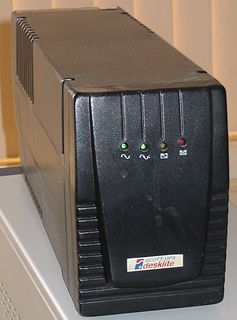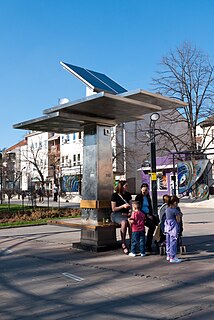
An uninterruptible power supply or uninterruptible power source (UPS) is an electrical apparatus that provides emergency power to a load when the input power source or mains power fails. A UPS differs from an auxiliary or emergency power system or standby generator in that it will provide near-instantaneous protection from input power interruptions, by supplying energy stored in batteries, supercapacitors, or flywheels. The on-battery run-time of most uninterruptible power sources is relatively short but sufficient to start a standby power source or properly shut down the protected equipment. It is a type of continual power system.

A rechargeable battery, storage battery, or secondary cell, is a type of electrical battery which can be charged, discharged into a load, and recharged many times, as opposed to a disposable or primary battery, which is supplied fully charged and discarded after use. It is composed of one or more electrochemical cells. The term "accumulator" is used as it accumulates and stores energy through a reversible electrochemical reaction. Rechargeable batteries are produced in many different shapes and sizes, ranging from button cells to megawatt systems connected to stabilize an electrical distribution network. Several different combinations of electrode materials and electrolytes are used, including lead–acid, zinc-air, nickel–cadmium (NiCd), nickel–metal hydride (NiMH), lithium-ion (Li-ion), Lithium Iron Phosphate (LiFePO4), and lithium-ion polymer.

Photovoltaics (PV) is the conversion of light into electricity using semiconducting materials that exhibit the photovoltaic effect, a phenomenon studied in physics, photochemistry, and electrochemistry.

A solar inverter or PV inverter, is a type of electrical converter which converts the variable direct current (DC) output of a photovoltaic (PV) solar panel into a utility frequency alternating current (AC) that can be fed into a commercial electrical grid or used by a local, off-grid electrical network. It is a critical balance of system (BOS)–component in a photovoltaic system, allowing the use of ordinary AC-powered equipment. Solar power inverters have special functions adapted for use with photovoltaic arrays, including maximum power point tracking and anti-islanding protection.
An atomic battery, nuclear battery, radioisotope battery or radioisotope generator is a device which uses energy from the decay of a radioactive isotope to generate electricity. Like nuclear reactors, they generate electricity from nuclear energy, but differ in that they do not use a chain reaction. Although commonly called batteries, they are technically not electrochemical and cannot be charged or recharged. In comparison they are very costly, but have an extremely long life and high energy density, and so they are mainly used as power sources for equipment that must operate unattended for long periods of time, such as spacecraft, pacemakers, underwater systems and automated scientific stations in remote parts of the world.

A battery charger, or recharger, is a device used to put energy into a secondary cell or rechargeable battery by forcing an electric current through it.

The term solar panel is used colloquially for a photo-voltaic (PV) module.
A charge controller, charge regulator or battery regulator limits the rate at which electric current is added to or drawn from electric batteries. It prevents overcharging and may protect against overvoltage, which can reduce battery performance or lifespan and may pose a safety risk. It may also prevent completely draining a battery, or perform controlled discharges, depending on the battery technology, to protect battery life. The terms "charge controller" or "charge regulator" may refer to either a stand-alone device, or to control circuitry integrated within a battery pack, battery-powered device, or battery charger.

A photovoltaic system, also PV system or solar power system, is a power system designed to supply usable solar power by means of photovoltaics. It consists of an arrangement of several components, including solar panels to absorb and convert sunlight into electricity, a solar inverter to convert the output from direct to alternating current, as well as mounting, cabling, and other electrical accessories to set up a working system. It may also use a solar tracking system to improve the system's overall performance and include an integrated battery solution, as prices for storage devices are expected to decline. Strictly speaking, a solar array only encompasses the ensemble of solar panels, the visible part of the PV system, and does not include all the other hardware, often summarized as balance of system (BOS). As PV systems convert light directly into electricity, they are not to be confused with other solar technologies, such as concentrated solar power or solar thermal, used for heating and cooling.

A solar lamp also known as solar light or solar lantern, is a lighting system composed of a LED lamp, solar panels, battery, charge controller and there may also be an inverter. The lamp operates on electricity from batteries, charged through the use of solar photovoltaic panel.
A battery management system (BMS) is any electronic system that manages a rechargeable battery, such as by protecting the battery from operating outside its safe operating area, monitoring its state, calculating secondary data, reporting that data, controlling its environment, authenticating it and / or balancing it.

A battery is a device consisting of one or more electrochemical cells with external connections for powering electrical devices such as flashlights, mobile phones, and electric cars. When a battery is supplying electric power, its positive terminal is the cathode and its negative terminal is the anode. The terminal marked negative is the source of electrons that will flow through an external electric circuit to the positive terminal. When a battery is connected to an external electric load, a redox reaction converts high-energy reactants to lower-energy products, and the free-energy difference is delivered to the external circuit as electrical energy. Historically the term "battery" specifically referred to a device composed of multiple cells, however the usage has evolved to include devices composed of a single cell.
SunCore Corporation is a company that produces light-powered intelligent charging systems to power today's mobile devices for original equipment manufacturers (OEMs), operators and distributors, cofounded in 2004 by The Brimmer Family in Irvine, California.

Solar cell phone chargers use solar panels to charge cell phone batteries. They can be used when no electricity supply is available—either mains or, for example, a vehicle battery—and are sometimes suggested as a way to charge phones without consuming mains electricity, unlike electrical cell phone chargers. Some can also be used as a conventional charger by plugging into an electrical outlet. Some chargers have an internal rechargeable battery which is charged in sunlight and then used to charge a phone; others charge the phone directly.

A Solar backpack is a backpack equipped with thin film solar cells and batteries. The solar panels convert sunlight into electricity, which is stored in the batteries and can be used to power portable electronic appliances like mobile phones and mp3 players.
SolarJOOS is a solar power company founded in 2008. The company builds an efficient and rugged portable solar charger used to charge cell phones and other portable electronic devices. The company's product, the JOOS Orange, won the 2011 Consumer Electronics Association's Best of Innovations Award and was featured in the Best of Innovations Showcase at the 2011 CES event in Las Vegas, Nevada.
Polarizing organic photovoltaics (ZOPV) is a concept for harvesting energy from Liquid crystal display screens, developed by engineers from UCLA. This concept enables devices to utilize external light and the LCD screen's backlight using photovoltaic polarizers. Photovoltaic polarizers convert this light into electricity which can be used to power the device. This concept also provides multifunctional capability to devices with LCD screens as they act as photovoltaic devices and also as polarisers.
Flexible solar cell research is a research-level technology, an example of which was created at the Massachusetts Institute of Technology in which solar cells are manufactured by depositing photovoltaic material on flexible substrates, such as ordinary paper, using chemical vapor deposition technology. The technology for manufacturing solar cells on paper was developed by a group of researchers from the Massachusetts Institute of Technology with support from the National Science Foundation and the Eni-MIT Alliance Solar Frontiers Program.
The following outline is provided as an overview of and topical guide to solar energy:

The Strawberry Tree is the world’s first public solar charger for mobile devices. It was developed by Serbian company Strawberry Energy. It won first place in the European Commission’s "Sustainable energy week 2011" competition in Brussels, in the category Consuming.

















